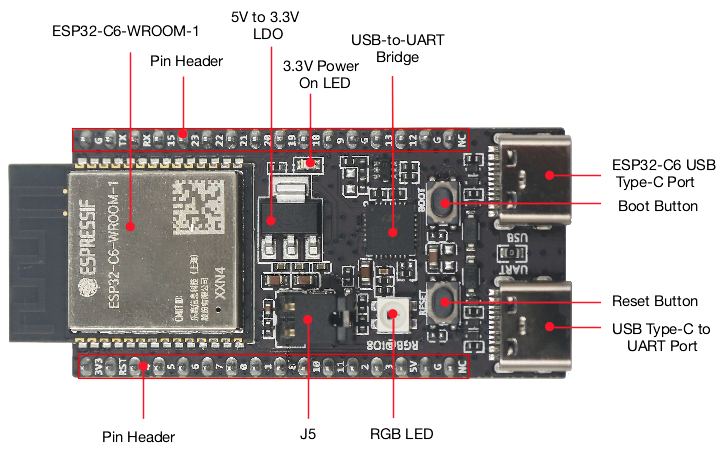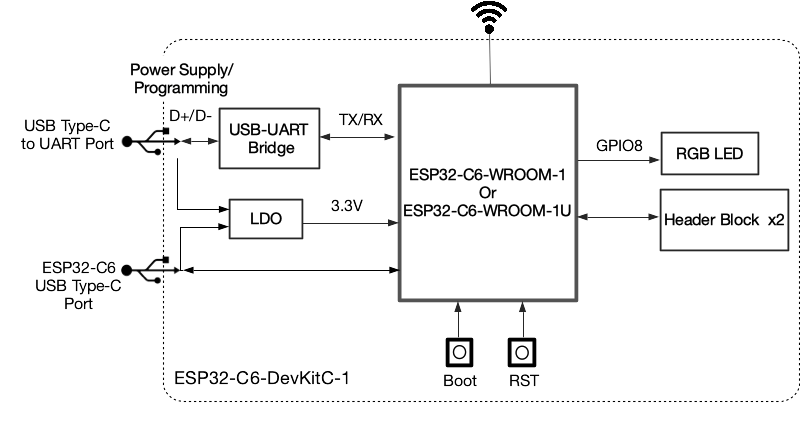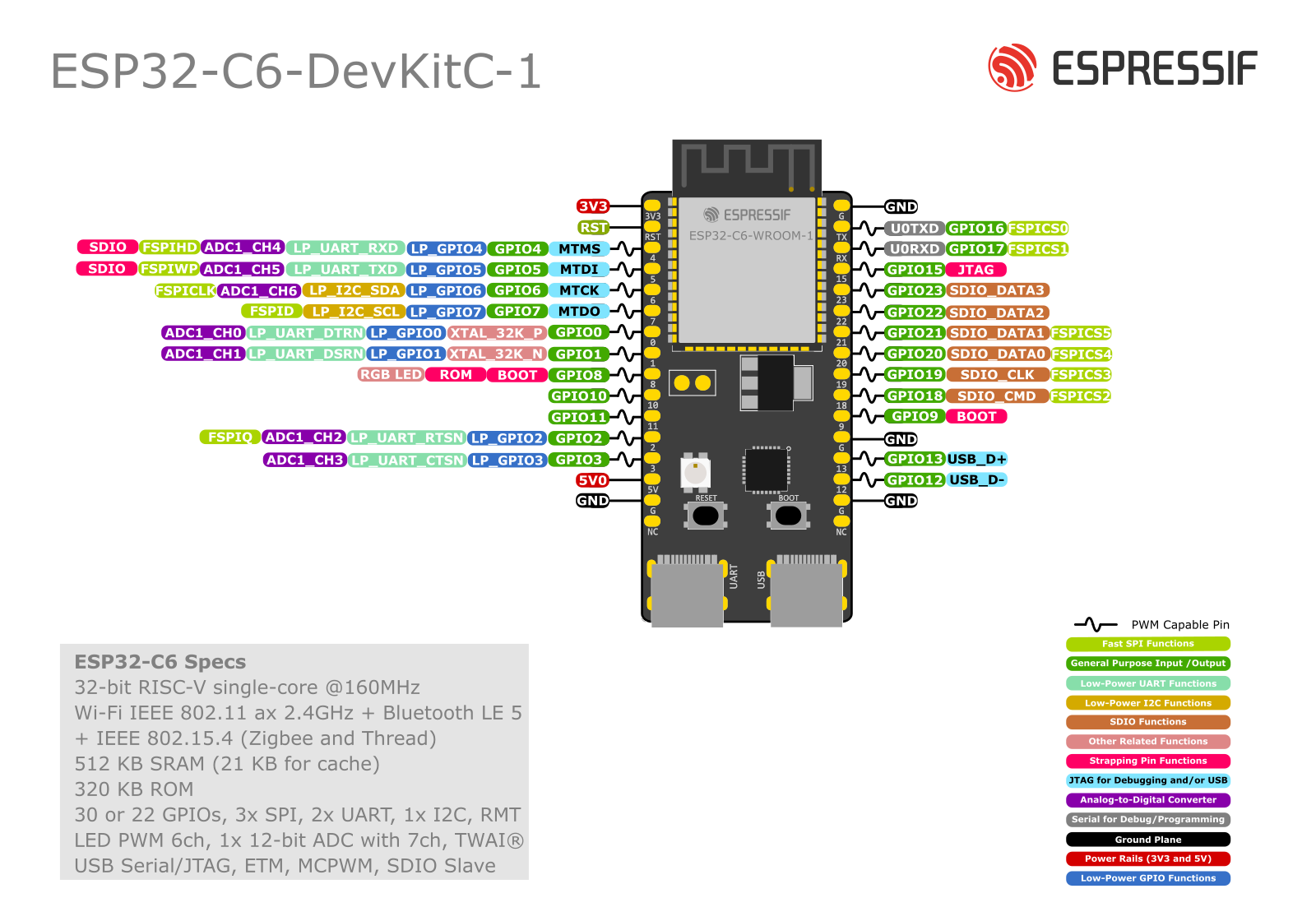
Reference: RBD-1407
Banner




ESP32-C6-WROOM-1 and ESP32-C6-WROOM-1U are general-purpose modules supporting Wi-Fi 6 in 2.4 GHz band, Bluetooth 5, and IEEE 802.15.4 (Zigbee 3.0 and Thread 1.3). They are built around the ESP32-C6 chip, and comes with a 8 MB SPI flash. ESP32-C6-WROOM-1 uses on-board PCB antenna, whereas ESP32-C6-WROOM-1U uses external antenna connector. For more information, see ESP32-C6-WROOM-1 Datasheet.
 Security policy
Security policy
(edit with the Customer Reassurance module)
 Delivery policy
Delivery policy
(edit with the Customer Reassurance module)
 Return policy
Return policy
(edit with the Customer Reassurance module)
This section provides a brief introduction of ESP32-C6-DevKitC-1, instructions on how to do the initial hardware setup and how to flash firmware onto it.

ESP32-C6-DevKitC-1 - front
The key components of the board are described in a clockwise direction.
|
Key Component |
Description |
|---|---|
|
ESP32-C6-WROOM-1 or ESP32-C6-WROOM-1U |
ESP32-C6-WROOM-1 and ESP32-C6-WROOM-1U are general-purpose modules supporting Wi-Fi 6 in 2.4 GHz band, Bluetooth 5, and IEEE 802.15.4 (Zigbee 3.0 and Thread 1.3). They are built around the ESP32-C6 chip, and comes with a 8 MB SPI flash. ESP32-C6-WROOM-1 uses on-board PCB antenna, whereas ESP32-C6-WROOM-1U uses external antenna connector. For more information, see ESP32-C6-WROOM-1 Datasheet. |
|
Pin Header |
All available GPIO pins (except for the SPI bus for flash) are broken out to the pin headers on the board. |
|
5 V to 3.3 V LDO |
Power regulator that converts a 5 V supply into a 3.3 V output. |
|
3.3 V Power On LED |
Turns on when the USB power is connected to the board. |
|
USB-to-UART Bridge |
Single USB-to-UART bridge chip provides transfer rates up to 3 Mbps. |
|
ESP32-C6 USB Type-C Port |
The USB Type-C port on the ESP32-C6 chip compliant with USB 2.0 full speed. It is capable of up to 12 Mbps transfer speed (Note that this port does not support the faster 480 Mbps high-speed transfer mode). This port is used for power supply to the board, for flashing applications to the chip, for communication with the chip using USB protocols, as well as for JTAG debugging. |
|
Boot Button |
Download button. Holding down Boot and then pressing Reset initiates Firmware Download mode for downloading firmware through the serial port. |
|
Reset Button |
Press this button to restart the system. |
|
USB Type-C to UART Port |
Used for power supply to the board, for flashing applications to the chip, as well as the communication with the ESP32-C6 chip via the on-board USB-to-UART bridge. |
|
RGB LED |
Addressable RGB LED, driven by GPIO8. |
|
J5 |
Used for current measurement. See details in Section Current Measurement. |
Before powering up your ESP32-C6-DevKitC-1, please make sure that it is in good condition with no obvious signs of damage.
ESP32-C6-DevKitC-1
USB-A to USB-C cable
Computer running Windows, Linux, or macOS
Note
Be sure to use a good quality USB cable. Some cables are for charging only and do not provide the needed data lines nor work for programming the boards.
Please proceed to ESP-IDF Get Started, which will quickly help you set up the development environment then flash an application example onto your board.
If you order a few samples, each ESP32-C6-DevKitC-1 comes in an individual package in either antistatic bag or any packaging depending on your retailer.
For retail orders, please go to https://www.espressif.com/en/company/contact/buy-a-sample.
If you order in bulk, the boards come in large cardboard boxes.
For wholesale orders, please check Espressif Product Ordering Information (PDF)
The block diagram below shows the components of ESP32-C6-DevKitC-1 and their interconnections.

ESP32-C6-DevKitC-1 (click to enlarge)
There are three mutually exclusive ways to provide power to the board:
USB Type-C to UART Port and ESP32-C6 USB Type-C Port (either one or both), default power supply (recommended)
5V and GND pin headers
3V3 and GND pin headers
The J5 headers on ESP32-C6-DevKitC-1 (see J5 in Figure ESP32-C6-DevKitC-1 - front) can be used for measuring the current drawn by the ESP32-C6-WROOM-1(U) module:
Remove the jumper: Power supply between the module and peripherals on the board is cut off. To measure the module’s current, connect the board with an ammeter via J5 headers.
Apply the jumper (factory default): Restore the board’s normal functionality.
Note
When using 3V3 and GND pin headers to power the board, please remove the J5 jumper, and connect an ammeter in series to the external circuit to measure the module’s current.
The two tables below provide the Name and Function of the pin headers on both sides of the board (J1 and J3). The pin header names are shown in Figure ESP32-C6-DevKitC-1 - front. The numbering is the same as in the ESP32-C6-DevKitC-1 Schematic (PDF).
|
No. |
Name |
Type 1 |
Function |
|---|---|---|---|
|
1 |
3V3 |
P |
3.3 V power supply |
|
2 |
RST |
I |
High: enables the chip; Low: disables the chip. |
|
3 |
4 |
I/O/T |
MTMS 3, GPIO4, LP_GPIO4, LP_UART_RXD, ADC1_CH4, FSPIHD |
|
4 |
5 |
I/O/T |
MTDI 3, GPIO5, LP_GPIO5, LP_UART_TXD, ADC1_CH5, FSPIWP |
|
5 |
6 |
I/O/T |
MTCK, GPIO6, LP_GPIO6, LP_I2C_SDA, ADC1_CH6, FSPICLK |
|
6 |
7 |
I/O/T |
MTDO, GPIO7, LP_GPIO7, LP_I2C_SCL, FSPID |
|
7 |
0 |
I/O/T |
GPIO0, XTAL_32K_P, LP_GPIO0, LP_UART_DTRN, ADC1_CH0 |
|
8 |
1 |
I/O/T |
GPIO1, XTAL_32K_N, LP_GPIO1, LP_UART_DSRN, ADC1_CH1 |
|
9 |
8 |
I/O/T |
|
|
10 |
10 |
I/O/T |
GPIO10 |
|
11 |
11 |
I/O/T |
GPIO11 |
|
12 |
2 |
I/O/T |
GPIO2, LP_GPIO2, LP_UART_RTSN, ADC1_CH2, FSPIQ |
|
13 |
3 |
I/O/T |
GPIO3, LP_GPIO3, LP_UART_CTSN, ADC1_CH3 |
|
14 |
5V |
P |
5 V power supply |
|
15 |
G |
G |
Ground |
|
16 |
NC |
– |
No connection |
|
No. |
Name |
Type |
Function |
|---|---|---|---|
|
1 |
G |
G |
Ground |
|
2 |
TX |
I/O/T |
U0TXD, GPIO16, FSPICS0 |
|
3 |
RX |
I/O/T |
U0RXD, GPIO17, FSPICS1 |
|
4 |
15 |
I/O/T |
GPIO15 3 |
|
5 |
23 |
I/O/T |
GPIO23, SDIO_DATA3 |
|
6 |
22 |
I/O/T |
GPIO22, SDIO_DATA2 |
|
7 |
21 |
I/O/T |
GPIO21, SDIO_DATA1, FSPICS5 |
|
8 |
20 |
I/O/T |
GPIO20, SDIO_DATA0, FSPICS4 |
|
9 |
19 |
I/O/T |
GPIO19, SDIO_CLK, FSPICS3 |
|
10 |
18 |
I/O/T |
GPIO18, SDIO_CMD, FSPICS2 |
|
11 |
9 |
I/O/T |
GPIO9 3 |
|
12 |
G |
G |
Ground |
|
13 |
13 |
I/O/T |
GPIO13, USB_D+ |
|
14 |
12 |
I/O/T |
GPIO12, USB_D- |
|
15 |
G |
G |
Ground |
|
16 |
NC |
– |
No connection |
P: Power supply; I: Input; O: Output; T: High impedance.
Used to drive the RGB LED.
MTMS, MTDI, GPIO8, GPIO9, and GPIO15 are strapping pins of the ESP32-C6 chip. These pins are used to control several chip functions depending on binary voltage values applied to the pins during chip power-up or system reset. For description and application of the strapping pins, please refer to ESP32-C6 Datasheet > Section Strapping Pins.

ESP32-C6-DevKitC-1 Pin Layout (click to enlarge)
For boards with the PW number of and after PW-2023-02-0139 (on and after February 2023), J5 is changed from straight headers to curved headers.
For boards with the PW number of and after PW-2023-07-XXXX (on and after July 2023), multi-point calibration is performed on ADC instead of two-point calibration, and the measurement range and accuracy are illustrated in ESP32-C6 Datasheet > Section ADC Characteristics. For boards with eariler PW number, please ask our sales team to provide the actual range and accuracy according to batch.
For boards with the PW number of and after PW-2023-07-0440 (on and after July 2023), to optimize the WS2812 driving circuit, the resistance of R29 is updated from 4.7 kΩ to 10 kΩ, and the resistance of R6 is updated from 10 kΩ to 3.3 kΩ. For details, see
Specific References
Your review appreciation cannot be sent
Report comment
Report sent
Your report cannot be sent
Write your review
Review sent
Your review cannot be sent
Reference: RBD-1407
Reference: RBD-2887
Reference: RBD-2381
Reference: RBD-0318
Reference: RBD-1020
Reference: RBD-2545
Reference: RBD-1134
Reference: RBD-2219
Reference: RBD-0552
Reference: RBD-0273
Brand: Waveshare
Reference: RBD-1255
Reference: RBD-2771
Brand: Waveshare
Reference: RBD-0698
Reference: RBD-1641
Reference: RBD-0308
Reference: RBD-2830
Brand: DFRobot

ESP32-C6-WROOM-1 and ESP32-C6-WROOM-1U are general-purpose modules supporting Wi-Fi 6 in 2.4 GHz band, Bluetooth 5, and IEEE 802.15.4 (Zigbee 3.0 and Thread 1.3). They are built around the ESP32-C6 chip, and comes with a 8 MB SPI flash. ESP32-C6-WROOM-1 uses on-board PCB antenna, whereas ESP32-C6-WROOM-1U uses external antenna connector. For more information, see ESP32-C6-WROOM-1 Datasheet.
check_circle
check_circle